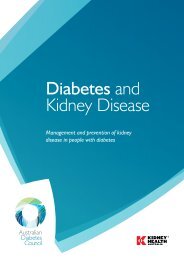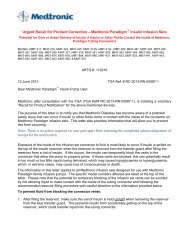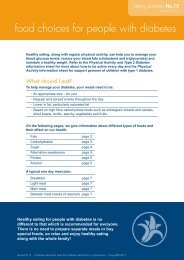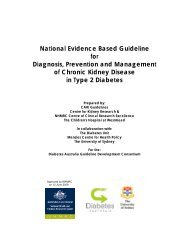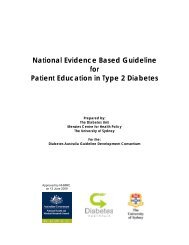Part 6: Detection and Prevention of Foot Problems in Type 2 Diabetes
Part 6: Detection and Prevention of Foot Problems in Type 2 Diabetes
Part 6: Detection and Prevention of Foot Problems in Type 2 Diabetes
Create successful ePaper yourself
Turn your PDF publications into a flip-book with our unique Google optimized e-Paper software.
Summary - <strong>Detection</strong> <strong>of</strong> Loss <strong>of</strong> Protective <strong>Foot</strong> Sensation• A loss <strong>of</strong> sensation to the 5.07 Semmes-We<strong>in</strong>ste<strong>in</strong> mon<strong>of</strong>ilament which exerts a10g pressure at buckl<strong>in</strong>g po<strong>in</strong>t <strong>in</strong>dicates loss <strong>of</strong> protective foot sensation• Failure to feel the 10g Semmes-We<strong>in</strong>ste<strong>in</strong> mon<strong>of</strong>ilament at one uncallused plantarsite is predictive <strong>of</strong> future foot ulceration• The 10g Semmes-We<strong>in</strong>ste<strong>in</strong> mon<strong>of</strong>ilament is equivalent to or better than othersimple tests <strong>of</strong> neuropathy for the primary care sett<strong>in</strong>g• The Semmes-We<strong>in</strong>ste<strong>in</strong> mon<strong>of</strong>ilament test is simple <strong>and</strong> its reliability is cl<strong>in</strong>icallyacceptable• Data on the optimal number <strong>and</strong> location <strong>of</strong> sites for test<strong>in</strong>g with 10g Semmes-We<strong>in</strong>ste<strong>in</strong> mon<strong>of</strong>ilament are limited <strong>and</strong> further research is required• The limited available data suggest that test<strong>in</strong>g at two sites, over the first <strong>and</strong> fifthmetatarsal heads, is sufficient to identify loss <strong>of</strong> protective sensation45




